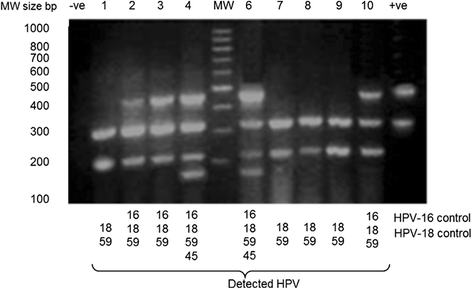Prevalence of human papillomavirus genotypes among women with cervical cancer in Ghana
- PMID: 26816527
- PMCID: PMC4727324
- DOI: 10.1186/s13027-016-0050-4
Prevalence of human papillomavirus genotypes among women with cervical cancer in Ghana
Abstract
Background: Human Papillomavirus (HPV) infections have been shown to be a necessary risk factor for the development of cervical cancer. However, HPV genotype distribution varies geographically, both in type and relative prevalence. In order to ensure a successful introduction of available vaccines, there is the need to identify pre-vaccination HPV genotype prevalence in Ghana and the extent of single and multiple-infections.
Methods: Paraffin-embedded cervical tissues of 256 confirmed cervical cancer cases diagnosed at the Korle-Bu Teaching Hospital during the period January 2004 to December 2006 were selected after hematoxylin and eosin staining and confirmation. Following a heat-proteinase K-based tissue lysis, HPV was detected and typed by a nested-multiplex PCR assay using an E6/E7 consensus primer and type-specific primers.
Results: Of the 256 cases, 230 (89.8 %, 95 % CI 85.7-93.4 %) were positive for HPV DNA. HPV18 (47.4 %), HPV59 (42.2 %), HPV45 (37.4 %) and HPV16 (9.0 %) were the four common HPV genotypes detected. A total of 110 (47.8 %) of the 230 HPV DNA positive tissues, were infected by a single HPV genotype while the other 120 (52.2 %) were infected by multiple HPV genotypes. A significant association was determined between each of the following HPV genotypes and multiple-infection; HPV18 (OR = 6.97; 95 % CI, 3.89-12.50), HPV59 (OR = 9.56; 95 % CI, 5.57-20.02) and HPV45 (OR = 1.94; 95 % CI, 1.12-3.35).
Conclusion: The prevalence of the following high risk HPV genotypes (HPV18, HPV59, HPV45) were relatively high among the cases of cervical cancers reported at this hospital in Ghana during the study period. Additionally, there was a high frequency of HPV multiple-infections among these cases.
Keywords: Cervical cancer; Ghana; Human Papillomavirus; Multiplex PCR; Nested PCR; Paraffin-embedded tissues.
Figures


References
-
- Nkyekyer K. Pattern of gynaecological cancers in Ghana. East Afr Med J. 2000;77(10):534–8. - PubMed
LinkOut - more resources
Full Text Sources
Other Literature Sources

